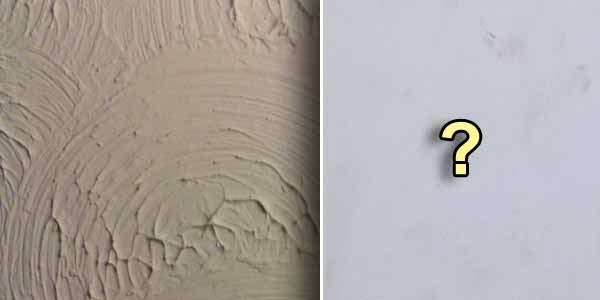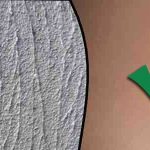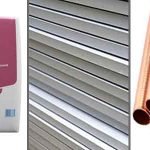As trends have changed, more people are now looking to remove Artex from their homes. However, removing it can prove to be a health hazard and a hassle, so you might choose an alternative method.
This can include dot and dab plasterboards. These will allow you to hide the Artex, giving you a blank surface to add your own style.
So, is it possible to dot and dab over Artex and what sort of considerations do you need to make when doing so?
If you are thinking about using dot and dab on Artex, you will have a few things to consider. While it is possible to dot and dab over Artex, you will need to check the condition of the wall first.
There is a possibility that the Artex might be pulling away from the wall. It might be cracked, blown, or bubbled, which means that the dot and dab would not have a secure grip on the wall.
If the Artex is painted, you would also need to make sure that the paint is not flaking away or loose.
If the existing substrate is solid, then it is definitely possible to dot and dab over Artex. However, you should use mechanical fixings if the boards are being fitted to a stud wall. You could also consider fitting battens to a solid wall and screwing your boards in place. This may provide a better hold, that is more secure.
Dot and Dab Over Artex Walls

It can be tempting to get rid of your Artex, as you look to achieve a smoother, modern finish. Artex is an old-fashioned trend that can be difficult to remove and time-consuming too. Therefore, you might be thinking about boarding straight over it.
If you opt to take this option, you will need to carry out some prep work beforehand. As Artex can be old, there is every chance that it is damaged or it has weakened. When fitting dot and dab plasterboard, it’s important that the surface is damage-free. This means that the Artex needs to be secure to the wall.
Should there be any signs of failure, then you will need to consider other options. This might include removing Artex or using a different method to secure the boards to the wall.
If you have identified that the walls are safe and secure, then you can go ahead and fit your dot and dab plasterboards. You will need to give the wall a clean to ensure that it is free of dust and dirt, this will enable the adhesive to bond to the surface.
You can then apply the adhesive and position your plasterboards in place.
Can You Overboard and Artex Ceiling?
Artex is commonly seen on ceilings, but homeowners are now looking to remove this look completely. One of the easiest ways to get rid of the Artex look is to fit plasterboards over the top.
While you might opt for dot and dab on the walls, you will need to use a different method for your ceilings. While dot and dab adhesive is extremely strong, it is not recommended that you use it to overboard ceilings. This is because it relies on suction for the adhesive to bond to the surface. If this fails to keep hold, the boards are heavy and could fall off.
The correct method is to screw the boards directly to the ceiling joists. Before you do this, you will need to ensure that any peaks are removed from the artex. This will give a smoother finish, so the boards sit flat on the surface.
You will need to find the ceiling joists before you begin fitting the plasterboards. To do this, you can lift the floorboards on any floors above and measure the distance of the joists from the walls and the distance between them. For ceilings upstairs, you can find the spacing between joists by going into your loft. Once you find the joists they can be marked on the walls using a pencil or some chalk.
It is also possible to find ceiling joists using a bradawl or a screw. This will enable you to pierce the existing ceiling to find the joists. It also means you don’t have to pull up floorboards or climb into your loft.
Once the joists have been found, you can then begin to secure your plasterboard in place using 38mm plasterboard screws. The screws will need to be fitted directly into the joists; this will ensure that you achieve a secure finish.
Can You Safely Remove Artex? Does it Contain Asbestos?
As Artex is found in older properties, there is a good chance it could contain Asbestos. This was used to add strength to Artex, but it is extremely harmful. Asbestos was used in Artex up until 1984, so if you are certain that the Artex was applied before this, you will need to consider how it is removed safely.
If you are unsure whether your Artex contains Asbestos, it is recommended that you have it tested. However, Asbestos was banned in the UK in August 1999, so if you are certain that it was applied after this, then you could consider removing it yourself.
Should your Artex be safe to remove, the best option is to use a steamer. This will help to soften and loosen the Artex, allowing you to scrape it off easily. However, you should not steam it for too long as it can become runny, making a mess. There are also chemical products available that turn the Artex to gel so you can scrape it off.
If the Artex does contain Asbestos, and you want it removed, then you should seek out professional assistance. A professional will have the right equipment and use the correct methods to remove it safely.
Conclusion
If you want to overboard your Artexed walls or ceilings, then it is certainly possible. Before you fit any plasterboards in place, you should make sure that the Artex is in excellent condition. It should be secure and solid while any paint should also be in pristine condition.
You can use dot and dab on your walls which will provide a solid finish. However, you will need to use mechanical fittings when you are overboard your ceiling. This will ensure that the plasterboards are fitted safely and securely. Also, before undertaking either task, you should always make sure you carry out the right prep work to achieve a perfect finish.




